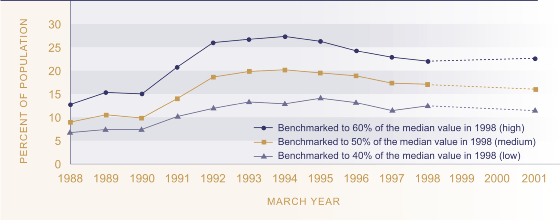Relevance
Insufficient economic resources limit people's ability to participate and belong to their community and wider society and otherwise restrict their quality of life. Furthermore, a consistent finding across the literature on outcomes for children is that low family income in childhood, if it is long-lasting, is associated with negative outcomes, such as lower educational attainment and poor health.
Current Level And Trends
In the year to June 2001, 22.6 percent of the population were living below the 60 percent threshold, a slight increase on the proportion in the previous survey year to March 1998 (22.0 percent). On all three measures (low, medium, and high), the proportion of the population with low incomes increased sharply in the early 1990s, reached a peak in the mid-1990s, and declined over the latter half of the decade. However, in 2001, the proportion of the population below these thresholds was still substantially higher than it had been in 1988.
The increase in the proportion of the population with low incomes through the early 1990s is attributable to high rates of unemployment and declines in the level of social assistance. The recent improvement in this measure may likewise reflect more robust economic (and income) growth, and the steady decline in unemployment.
Figure EC3.1 Lines showing proportions
of population with net-of-housing-cost incomes below thresholds,
1988-1998, 2001

Source: Derived from Statistics
New Zealand's Household Economic Survey, 1988-2001, by the
Ministry of Social Development
Population Group Differences
In 2001, 29.1 percent of dependent children were in economic family units below the 60 percent line (benchmarked to the 1998 median). This represents an increase from 27.5 percent in 1998 and is almost twice the proportion in 1988 (14.6 percent), but substantially below the peak of 36.4 percent in 1994. For people aged 15 years or over, females (21.8 percent) were a little more likely to be in low income households than males (19.5 percent) in 2001.
Economic families most likely to be living with low incomes are: families reliant on income-tested benefits, sole-parent families, families with at least one adult belonging to an ethnic group other than European, families in rented dwellings and families with dependent children. The situation improved for most of these family types between 1993 and 1998. However, for sole-parent families the proportion below the 60 percent benchmark line increased again between 1998 and 2001.
Table EC3.1 Proportion of population with net-of-housing-cost incomes below the 60 percent line (benchmarked to 1998 median), 1988, 1993, 1998, 2001
| 1987-88 | 1992-93 | 1997-98 | 2000-01 | |
|---|---|---|---|---|
| Total population | 12.7 | 26.7 | 22.0 | 22.6 |
| Total dependent children | 14.6 | 34.7 | 27.5 | 29.1 |
| Children in sole-parent families | 18.5 | 65.6 | 59.2 | 66.3 |
| Children in two-parent families | 13.8 | 27.5 | 18.5 | 19.7 |
| Males (15 years & over) | 11.9 | 23.3 | 19.6 | 19.5 |
| Females (15 years & over) | 12.2 | 24.9 | 20.8 | 21.8 |
| Total economic families | 14.0 | 28.0 | 23.2 | 23.2 |
| Economic families | ||||
| With one dependent child | 11.5 | 30.1 | 25.2 | 26.5 |
| With two dependent children | 11.7 | 32.9 | 23.5 | 26.0 |
| With three or more dependent children | 18.6 | 40.8 | 30.7 | 32.7 |
| Sole-parent families | 17.4 | 62.5 | 51.9 | 59.4 |
| Two-parent families | 12.4 | 25.1 | 17.0 | 17.5 |
| Economic families | ||||
| With any Maori adult | 14.0 | 41.0 | 31.2 | 32.0 |
| With any Pacific adult | 24.4 | 48.9 | 44.3 | 40.0 |
| With any 'Other' ethnic group adult | 23.6 | 42.8 | 53.7 | 35.6 |
| With any European/Pākehā adult | 12.6 | 23.3 | 18.5 | 18.7 |
| Economic families with main source of income | ||||
| New Zealand Superannuation | 7.0 | 8.4 | 9.9 | 6.5 |
| Income-tested benefit | 26.0 | 74.3 | 61.7 | 61.6 |
| Housing tenure (households with one family unit) | ||||
| Rented | n.a | 43.3 | 37.2 | 33.5 |
| Owned with mortgage | n.a | 24.l3 | 15.3 | 17.1 |
| Owned without mortgage | n.a | 4.9 | 3.7 | 5.6 |
Source: Derived from Statistics New Zealand Household Economic Survey, by the Ministry of Social Development
International Comparison
Based on a slightly different measure, 60 percent of median equivalent disposable household income in 1995, and not taking housing costs into account, 13.7 percent of New Zealand households were living below the low income threshold, compared with an OECD median for the mid 1990s of 14.3 percent. New Zealand ranked ninth out of 22 OECD countries.53 This represents a higher proportion of households with a low (relative) income than the majority of European countries but a lower proportion of households compared with Canada, Australia, the United Kingdom and the United States.
